Stinging insects are not exactly the most popular living creatures in the world. Most people’s reaction to them is to swat them or run away. All it takes is one bee sting to know you don’t want to have that experience again! However, stinging insects like bees, wasps, and ants are really important to the natural balance of the ecosystem.
They pollinate flowers as they move from one plant to another. Many plants would not be able to reproduce without them. Additionally, they’re a major food source for other insects, birds, reptiles, and mammals. Conversely, they feed on many insects themselves, several of which can damage crops and plants. Lastly, they indicate how healthy the ecosystem is. Changes in their populations or behavior can be an early warning sign of environmental problems.
That’s all well and good, but still, none of us wants to get on the wrong end of their stingers! Read on to discover our picks for 10 of the most painful insect stings in the world. We’ll also cover what to do if you get stung, and how to get rid of stinging insects.
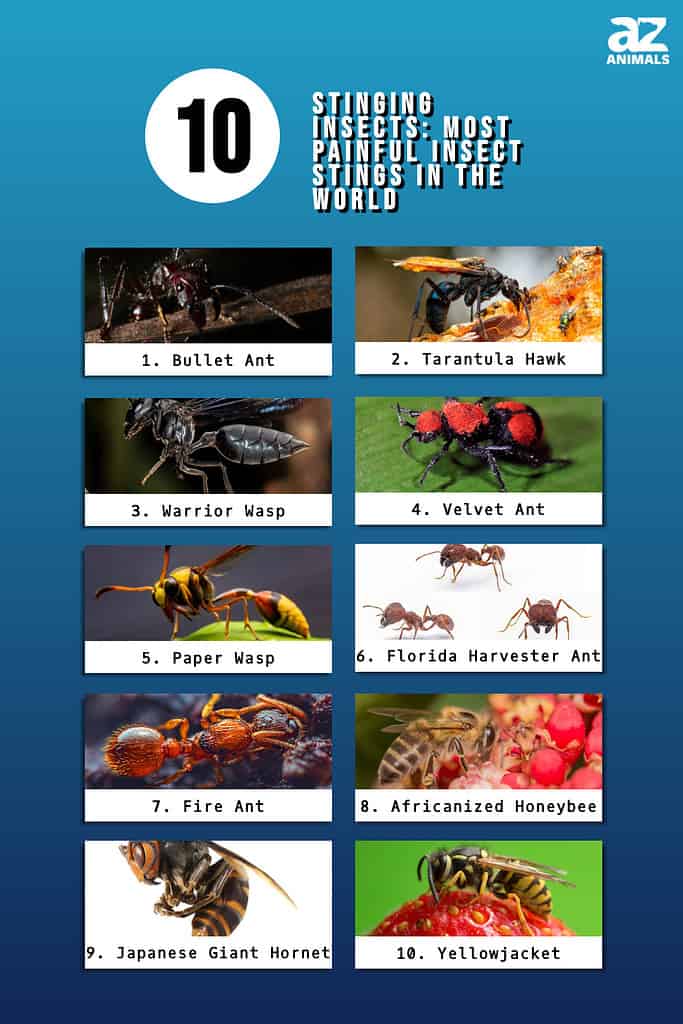
1. Bullet Ant

The world’s most painful insect, the bullet ant, is named for its extremely potent sting.
©Dan Olsen/Shutterstock.com
The bullet ant is at the top of nearly every expert’s list as the most painful of all insect stings. Native to Central and South America, this is one of the largest ant species in the world. It reaches a length of 1.2 inches. People who have experienced its sting say it feels like a gunshot, hence its name. Waves of burning, excruciating pain can last for 24 hours and get even more painful over time. In addition to sheer agony, victims can experience fever, nausea, trembling, and cardiac arrhythmia.
Fortunately, they are generally not considered an aggressive species. However, when they do sting, they release a chemical that signals all their friends to sting as well. Believe it or not, one Brazilian tribe uses these ants as a rite of passage for teenage boys. Young men prove their manhood by wearing a glove with bullet ants affixed, stingers pointed inward. The goal is to avoid showing any sign of pain. What do you think? Want to join the tribe?
2. Tarantula Hawk

Tarantula hawks are such dangerous wasps that they are often seen consuming a tarantula spider.
©Sari ONeal/Shutterstock.com
The tarantula hawk is an enormous wasp, reaching up to 2 inches long. They are indigenous to warm, humid climates in some parts of the Americas and Asia. These are really colorful creatures, coming in beautiful shades of blue, purple, or red, which gives them an aesthetic appeal. Don’t be mistaken, though, these are serious predators. They feed on a lot of different insects, including tarantulas that are eight times bigger than them! To accomplish this, the tarantula hawk stings the spider, paralyzing it with venom before dragging it back to its nest. Sounds scary, but they are not aggressive toward humans unless provoked. If you make that mistake, you could get a powerful sting that’s been described as similar to an electric shock. The pain from this can last several agonizing hours. You won’t make that mistake twice, that’s for sure.
3. Warrior Wasp

Warrior wasps have black or dark blue bodies with metallic-like shades.
©iStock.com/ViniSouza128
The warrior wasp is an aggressive, territorial paper wasp species found in tropical parts of South America. It gets its name from a fear-inducing practice. When the nest is threatened, the whole hive will beat their wings in rhythm, sounding remarkably like marching troops. Warrior wasps grow up to an inch long and have powerful jaws and a potent sting. Their venom contains a chemical called poneratoxin, which produces severe shooting pain and swelling. People stung by this species often require medical attention, especially as these wasps often defend their nest as a terrifying swarm.
4. Velvet Ant

The velvet ant’s sting is not toxic to humans but causes intense agony that has been compared to being stabbed or hit with shrapnel.
©Tarsal Claw/Shutterstock.com
Velvet ants are not really ants at all. They are colorful wingless female wasps with black bodies covered in soft-looking red, yellow, orange, or brown hairs. If you live in the southern or Southwestern United States, you’re most likely to see one when it emerges from its burrow to seek a mate. Some people have described the velvet ant as “cuddly” looking. You might be tempted to tough it, but that would be a mistake. The sting is not toxic to any mammal but causes intense pain likened to being stabbed or hit with shrapnel.
Velvet ants are also called “cow killers.” This name is an exaggeration, as their sting cannot literally kill a cow. But legends from the Old West tell of cows stepping in a nest and of cow stings getting infested with maggots. Deadly or not, you don’t want to mess with this ant-that-is-a-wasp.
5. Paper Wasp
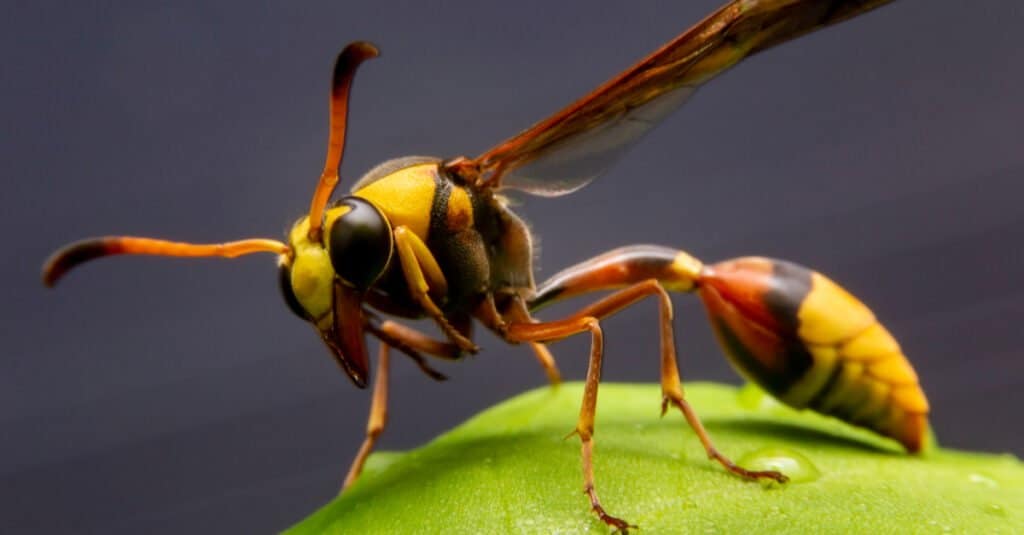
Paper wasps have a tendency to form nests under eaves and in the attics of houses.
©Witsawat.S/Shutterstock.com
There are over 1,000 species of paper wasps found all over the world. Paper wasps get their name from the nests they build out of saliva and wood fibers. They mold these into thin paper-like layers. Undisturbed, their nests can get huge and house colonies of over 200 wasps. They are often found in trees and shrubs in the wild. However, paper wasps also form nests under eaves and in the attics of houses and other structures.
They are generally not aggressive, but when they feel threatened, the entire hive can attack en masse. Their stings that have been described as “a drop of superheated frying oil” dripped on your skin. Although the sting is not highly toxic, it may produce burning pain, swelling, redness, and itching that lasts for hours.
6. Florida Harvester Ant
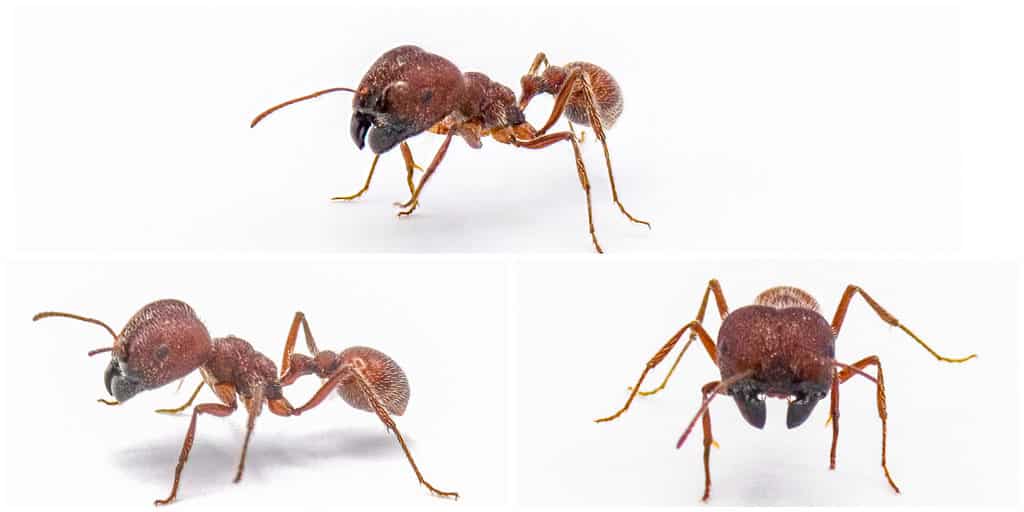
The Florida harvester ant’s sting is reputed to be one of the most painful of any ant species in the world.
©iStock.com/Dan Rieck
The term “harvester ant” applies to any ant species that gathers seeds or mushrooms and stores them in granary chambers as food for the colony. This activity can be very beneficial to the ecosystem because it disburses and plants seeds and aerates the soil. Harvester ants are native to North America. However, the only species found east of the Mississippi River is the Florida harvester ant. Their stings are reputed to be one of the most painful of any ant species in the world. The pain lasts several hours, causing swelling and a watery, oozy secretion from the site of the sting.
7. Fire Ant
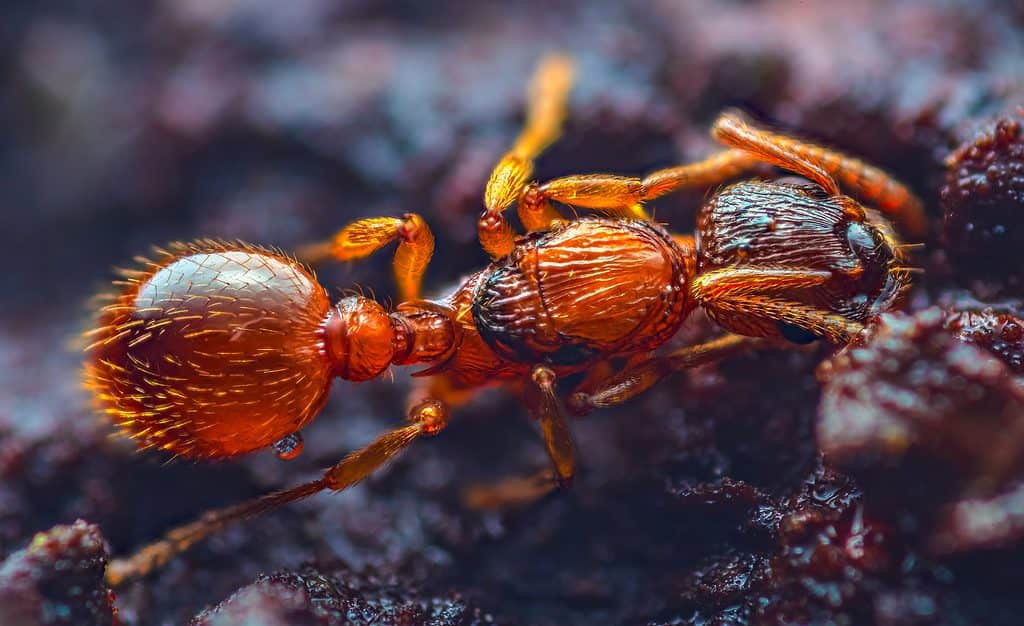
The sting of a fire ant is typically very painful, with a sharp, stinging sensation that can last for several hours.
©Lukas Jonaitis/Shutterstock.com
Fire ants are a type of stinging ant indigenous to South America. But it has spread to many other parts of the world (including North America, Europe, Asia, and Australia) through international trade and travel. In the United States, they are prevalent in southern and southwestern states. They are typically found in a variety of habitats, including forests, grasslands, and agricultural areas. And they are often active in and around homes. Because of their aggressive behavior and proximity to people, they are considered a major pest.
The sting of a fire ant is typically very painful, with a sharp sensation that can last for several hours. Some people have described the pain as feeling like a burn or a hot poker. The venom of a fire ant contains a chemical called solenopsin, which can cause irritation and inflammation. Oh, and if by chance you live on an island, don’t think being surrounded by water will keep you safe. Fire ants can link their bodies together to make massive floating chains to cross bodies of water!
8. Africanized Honeybee
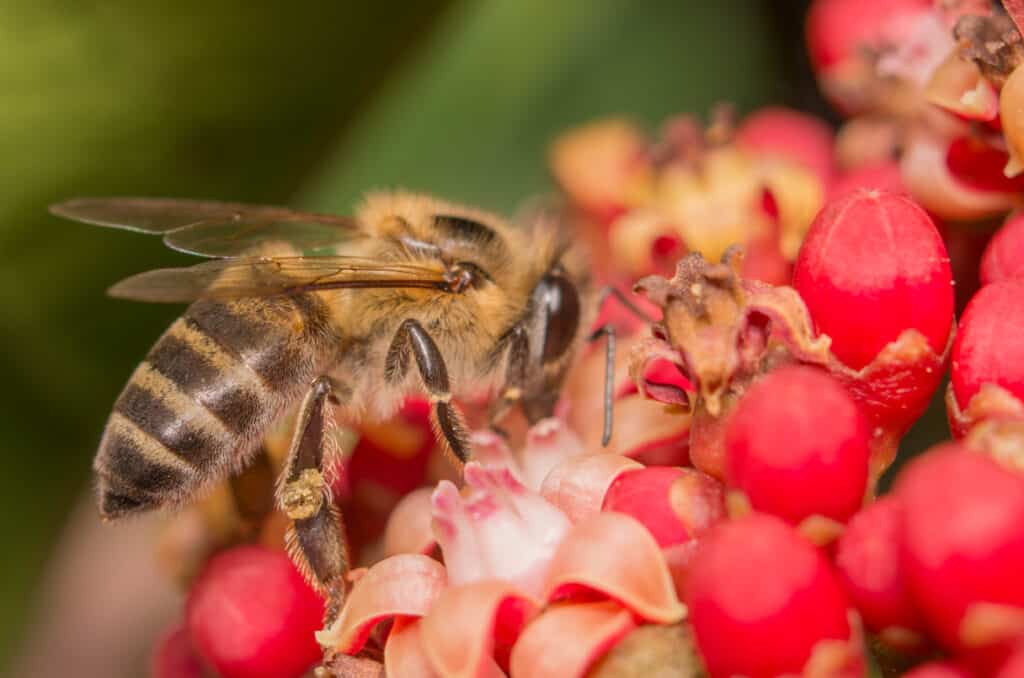
These bees are known for being highly aggressive, swarming, pursuing, and relentlessly stinging people or animals that get near their nests.
©Philip Marsden/Shutterstock.com
Africanized honeybees, also known as “killer bees,” are the unfortunate result of a science experiment gone dreadfully wrong. In the 1950s, researchers brought hardy, aggressive African honeybees to Brazil to use in experimental breeding programs. Disastrously, some escaped and began interbreeding with local populations of more docile European honeybees. The hybrid species went on to spread across South and Central America and into the Southwestern and Southern United States.
Africanized honeybees are highly aggressive, swarming, pursuing, and relentlessly stinging people or animals that get near their nests. Their sting itself is not particularly toxic, but it is sharp and painful. Large numbers of stings can cause life-threatening physiological reactions. Locations of nests should be reported to professionals for removal, as this species is a danger to people and animals in their range.
9. Japanese Giant Hornet
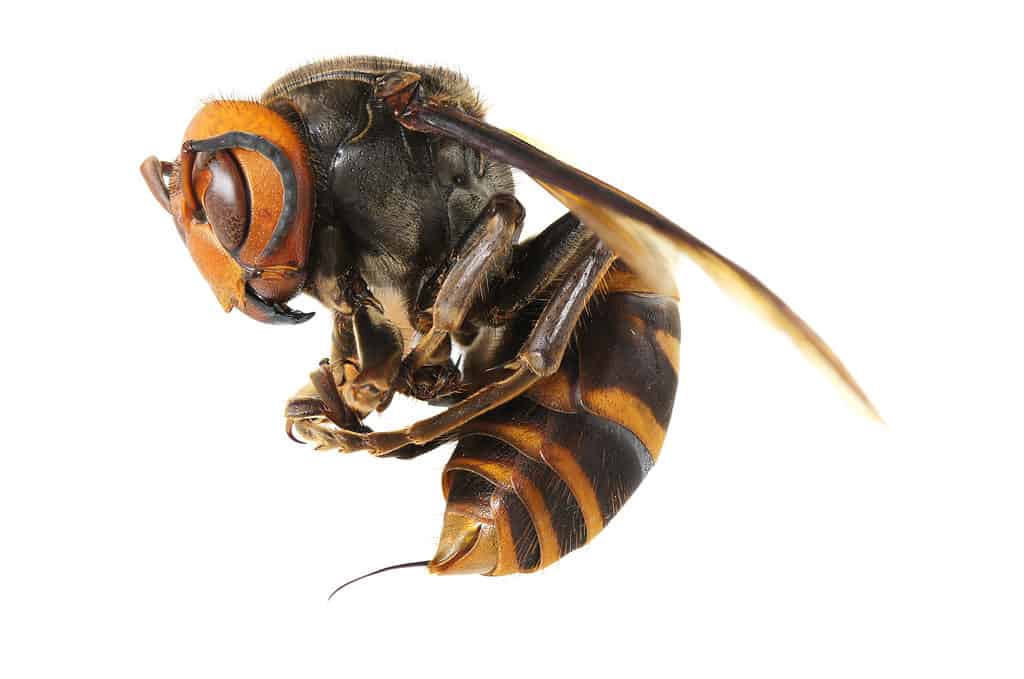
The venom of the Japanese giant hornet contains mandaratoxin, which can cause damage to the tissue around the sting site.
©Contrail/Shutterstock.com
The Japanese giant hornet, also known as the Asian giant hornet, is the largest hornet in the world. Amazingly, it is 1.75 inches long and has a wingspan of a whopping 3 inches! It is indigenous only to East Asia and the Russian Far East. However, from 2019-2021 a few specimens began to appear in the Pacific Northwest of the United States and Canada. This was likely the result of international travel and trade. Researchers found no reports of them the following year, so they hoped this meant eradication efforts had been successful. But with trade and travel drastically reduced during the COVID-19 pandemic, their disappearance may only be temporary. It’s possible that more stowaways will find their way to the Western Hemisphere with the resumption of normal international commerce.
This sting of the Japanese giant hornet is extraordinarily painful, producing a sharp burning sensation that can last for hours. Its venom contains mandaratoxin, which damages the tissue around the sting site and produces swelling, redness, and itching. The pain of the sting and the body’s reaction to it can produce nausea in some unfortunate people.
10. Yellowjacket

Unlike bees, whose stingers detach from their bodies after stinging, yellowjackets keep their stingers and can sting their victim multiple times.
©Henrik Larsson/Shutterstock.com
Yellowjacket is a term for various small predatory wasp species in North America. They are characteristically black and yellow, often in alternating bands, and they have a unique way of flying rapidly side-to-side before landing. They may build nests in the ground, in trees, or in hidden protected places such as barns or attics. Even though they helpfully prey on some harmful insect species, they also like many of the same foods humans do. It’s not unusual to find yellow jackets hovering around trashcans or attempting to sample your soda on a hot summer day.
Yellowjacket stings are not as painful as the other insects on our list, but they are still more than enough to ruin a perfectly good day, especially if you are attacked by multiple individuals. Their stings produce a burning and itching sensation that can last a couple of hours and can produce allergic reactions in some people.
They have been described as having an “angry disposition” because of their habit of going on the attack unprovoked and pursuing people even when they try to steer clear of them. Unlike bees, whose stingers detach from their bodies after stinging, yellowjackets keep their stingers and can sting their victim multiple times, a capability they readily use. Yellowjackets can also bite, but it is not clear whether they use that ability against humans or only when feeding. So next time you see something buzzing around a public trashcan, you might just want to cross the street.
Summary of the 10 Most Painful Insect Stings in the World
| Rank | Insect | Sting |
|---|---|---|
| 1 | Bullet Ant | Being stung feels like a gunshot with waves of pain lasting 24 hours, fever, trembling, and nausea. A sting can also cause an irregular heartbeat. |
| 2 | Tarantula Hawk | The sting feels like an electric shock, with pain lasting many hours. |
| 3 | Warrior Wasp | The venom causes shooting pain and swelling that may require medical attention. |
| 4 | Velvet Ant | The sting of this pretty but painful ant has been compared to being stabbed or hit with shrapnel. |
| 5 | Paper Wasp | Those who have been stung compare it to having a drop of hot frying oil on the skin. It causes pain, redness, swelling, and itching for hours. |
| 6 | Florida Harvester Ant | These ants’ stings are reputed to be among the most painful of any ant species. They can cause swelling and an oozing secretion from the wound. |
| 7 | Fire Ant | Fire ant stings feel like being touched with a hot poker. They cause inflammation, irritation, and pain lasting several hours. |
| 8 | Africanized Honeybee | One sting is sharply painful, but these bees swarm and can cause so many stings that people have been hospitalized and even died from them. |
| 9 | Japanese Giant Hornet | This sting burns, damages surrounding tissue, swells, and itches. It can also cause nausea. |
| 10 | Yellowjacket | Yellowjackets make burning, itching stings. They can sting more than once and swarm, inflicting life-threatening injuries on allergic people. |
The photo featured at the top of this post is © namtipStudio/Shutterstock.com
Sources
- Fact Animal, Available here: https://factanimal.com/bullet-ant/
- Brezden Pest Control, Available here: https://www.brezdenpest.com/10-painful-insect-bites-stings/
- Cramer Pest Control, Available here: https://cramerpestcontrol.com/blog/most-painful-insect-stings-in-the-world/
- Field & Stream, Available here: https://www.fieldandstream.com/10-worst-stings-in-wild/
- National Library of Medicine, Available here: https://www.ncbi.nlm.nih.gov/pmc/articles/PMC5864055/#:~:text=Swarm%2Dfounding%20'Warrior%20wasps',nest%20defence%20and%20painful%20sting.
- Animals.mom, Available here: https://animals.mom.com/cow-killer-wasps-called-this-4456.html
- Wikipedia.com, Available here: https://en.wikipedia.org/wiki/Asian_giant_hornet
- Ecoshield Pest Solutions, Available here: https://www.ecoshieldpest.com/blogs/do-yellowjackets-bite
Thank you for reading! Have some feedback for us? Contact the AZ Animals editorial team.






